|
 |
 |
|
Achillea millefolium
Yarrow, Northern or Common Yarrow, Milfoil, Nosebleed
Alaska to Mexico, throughout North America, Circumboreal
Family Asteraceae
Natuve
Yarrow is an herb that is widespread around the temperate world. It has a host of medicinal uses that include antimicrobial, analgesic, hemostatic, and styptic qualities that have made it, historically, an important wound treatment. Indeed, the generic name comes from Achilles who, in Greek mythology, applied yarrow leaves to his soldiers’ open wounds. Ground or powdered yarrow can be put on bee and wasp stings to relieve pain and swelling.
Yarrow is a perennial. Its white to rarely pink or red inflorescences are borne on the ends of erect stems in flat-topped clusters called corymbs, a flower structure common to numerous members of the Asteraceae. Yarrow has ray and disk flowers, its ray flowers rounded rather than long. The distinctive yarrow leaves are alternate and highly pinnately divided, making them appear fluffy and fern-like. It blooms in the summer along the hillside.
|
 |
 |
|
Anaphalis margaritacea
Pearly everlasting or cotton weed
Southern Alaska to California, most states outside of the Deep South
Family Asteraceae
Native
The pearly everlasting blooms from July into September. Each new flower has a set of thin, pearly white involucre bracts curled into a tight ball, giving the entire inflorescence an appearance of clusters of pearls. The bracts then gradually spread to reveal a center of bright yellow disk flowers. There are no ray flowers. The generic name comes from the Greek prefix “ana” meaning “up, upward, upon” and “phalos” for “light or shining white”. The specific name is derived from the Greek “margarites” for “pearl”. These flowers are arranged at the end of a single stem into a compound corymb.
The alternate leaves are lanceolate, or lance-shaped, shiny on top but with white wooly hairs covering the underneath side and the stems. They are reputed to have some medicinal value and have been used as a tobacco substitute. Sun lovers, pearly everlastings are common on dunes and sandy slopes.
|
 |
 |
|
Angelica hendersonii
Henderson’s angelica
Southern Washington to California
Family Apiaceae
Native
Angelica lucida
Sea-watch or seacoast angelica
Alaska to Northern California
Family Apiaceae
Native
There are two angelicas along our coast that typically inhabit the shoreline environment: Henderson’s angelica and sea-watch. We have mostly sea-watch between the Capes, but you can find both at Cape Meares. Angelica is from the Greek word ‘angelikos’ meaning heavenly or divine. Both angelicas are large plants, three to four feet tall, and are found in dunes near the ocean, especially where bluffs meet the beach. In the flowering stage, both plants look similar. The flowers are white and arranged in compound umbels. The easiest way to tell the difference between the plants is that the leaves of Henderson’s angelica are wooly underneath whereas the undersides of sea-watch are glabrous (without hairs). In the fruiting stage, the fruits of the former have lateral wings, and those of the latter have thick, corky ribs. A. lucida is also known as wild celery. Its young stems and leaves are eaten by native peoples, especially those in Alaska, and the plant, including the large taproot, is used an analgesic.
|
 |
 |
|
Aruncus dioicus
Goatsbeard, bride’s feathers
Alaska to Northern California, eastern states and provinces
Family Rosaceae
Native
Goatsbeard (or goat’s beard) is a tall perennial found in mid to low elevations in western Oregon. Locally we see it along roadsides, trails, streams, and logged areas. It has creamy-white male and female flowers arranged in panicles that bloom in early summer. Leaves are pinnately compound. Goasbeard spreads by rhizomes. Goatsbeard is also cultivated as a garden plant.
There are four varieties of A. dioicus. The western variety we have here is identified by the United States Department of Agriculture (USDA) as var. acuminatus (http://plants.usda.gov/java/profile?symbol=ARDI8). However, The Jepson Manual – Higher Plants of California (James C. Hickman, ed. 1993) and the Handbook of Western Plants by Gilkey and Dennis (2001) list it as var. pubescens, which the USDA says occurs only in Oklahoma and eastward.
|
 |
 |
|
Boykinia occidentalis
Coastal boykinia, western boykinia
British Columbia to California
Family Saxifragaceae
Native
Also known as Boykinia elata, the coastal boykinia is found in shaded forest areas west of the Cascade Mountains, from mid elevations to sea level. Look for it along the trails in Cape Lookout State Park. Flowers have five stamens and normally have five white petals, but the number may vary. The inflorescence is arranged in a panicle which stems from a leaf axil. Leaves are palmate and highly notched. Stems are covered with reddish hairs.
|
 |
 |
|
Cardamine occidentalis
Big western bitter-cress
Alaska to Northern California
Family Brassicaceae
Native
This member of the mustard family pictured below is probably Big Western Bitter-Cress (Cardamine occidentalis), which can sometimes be seen in the sand at the driftwood line. There are many species of Cardamine, and I am not positive of the species. The four-petal flowers are white and grow in clusters near the ends of the branches. The leaves are mostly at the base of the plant. They are deeply lobed to compound with sessile side lobes and one large terminal lobe. The fruits are long siliques. Big Western Bitter-Cress is scattered through Oregon.
|
 |
 |
 |
|
Castilleja ambigua subsp. ambigua
Johnny-nip, paintbrush owl's-clover
British Columbia to California
Family Scrophulariaceae
Native
Johnny-nips, mostly coastal, are common along the upper levels of the salt marsh near the southern end of Netarts Bay, especially during June and July. They are annual herbs with alternate, lance-shaped leaves and yellowish flowers arranged in a spike that are partly hidden by broad, leaf-like bracts. The tips of the bracts are usually colored white, looking as if they had been dipped in white paint. There are two other subspecies native only to California.
|
|
|
|
Claytonia perfoliata subsp. perfoliata
Miner’s lettuce
Southeastern Alaska to California.
Family Portulacaceae
Native (except possibly in Alaska)
Called miner’s lettuce because early miners used the leaves in salads, this edible plant has an unusual pair of fused, fleshy stem leaves just beneath the flower cluster that are fused to form a spoon-like disk, making miner’s lettuce easy to recognize. At the base of the plant is a rosette of oval leaves with long petioles, different from the fused stem leaves. Flowers are white to pale pink, with five petals, two sepals, and two stamens. Named for John Clayton, a botanist, it is common in the spring in shaded places. It is also known as Montia perfoliata.
|
|
|
 |
 |
|
Claytonia sibirica var. sibirica
Sibirian miner’s lettuce, candy flower, western spring beauty
Alaska to California
Family Portulacaceae
Native
You can find candy flowers in shaded parts of the trails during early summer in the Cape Lookout State Park and at the Cape Meares Scenic Viewpoint. The flowers are arranged in small, terminal clusters, and each has five white petals with red veins, two sepals, and two stamens. Each petal has a deep cleft on its end. There are basal leaves that are oval with long petioles, and a pair of heart-shaped stem leaves that are sessile but not fused.
|
|
|
 |
 |
|
Convolvulus arvensis
Orchard morning glory
All states except Alaska and most Canadian provinces
Family Convolvulaceae
Non-native
You can find two morning glories growing between the Capes: the orchard morning glory, Convolvulus arvensis, and the beach morning glory, Convolvulus soldanella also Calystegia soldanella, a native that inhabits sand dunes and beaches.
The orchard morning glory, also called field bindweed, is an introduced species from Europe that is considered a noxious weed. It has flowers with five white to pinkish petals that are fused. The flower is somewhat larger than that of its beach cousin Convolvulus soldanella. Its leaves are variable but generally hastate, that is arrowhead-shaped with the basal lobes flaring out. It is a trailing vine that spreads by rhizomes. The Nature Conservancy cites it as one of the world’s ten worst weeds. It winds around, binds, and chokes out crop plants, making it an agricultural pest. In Oregon, it is targeted for biological control.
|
|
|
 |
 |
|
Daucus carota
Wild carrot, Queen Ann’s lace
All of Continental United States and most of Canada
Family Apiaceae
Non-native
This is the wild form of the domestic carrot. If you pull it from the ground so the root comes free, you can smell the distinct odor of carrot. The five-petal, white flowers are arranged in a compound umbel, subtended by thin, pinnately divided bracts. The leaves are tripinnately divided and resemble those of the cultivated carrot. The stems bear small, stiff hairs. It is common in our area along roadsides from early summer into autumn. It is native to Europe and was introduced into North America as a medicinal plant.
|
 |
 |
|
Disporum smithii
Smith’s fairybell, coast fairybell, fairy lantern
British Columbia to California
Family Liliaceae
Native
Blooming in May, Smith’s fairybell can be found in moist and shaded woods west of the Cascade Mountains. Its white flowers hang from the undersides of stems in small clusters, maturing to produce orange to red berries. The leaves are sessile, alternate, broadly lance-shaped to oval with rather pointed tips, and have prominent veins. The stem often angles where leaves attach. Look for Smith’s fairybell along our local wooded trails.
|
|
|
 |
 |
|
Fallopia sachalinense
Giant knotweed
Coastal areas from Alaska to California, Eastern States and Provinces
Family Polygonaceae
Non-native
Often included in the wider genus Polygonum or in the genus Reynoutria, giant knotweed is native to the Sakhalin Islands of northern Japan (hence the specific name) that has invaded much of North America and Europe. This imported pest, like Japanese and Himalayan knotweeds, spreads by rhizomes and, once established, is difficult to eliminate. It is a perennial that grows to over 12 feet tall with heart-shaped (cordate) leaves that may be over a foot long. The stems are hollow and jointed, giving the appearance of bamboo. Flowers are arranged in a panicle, with pistallate and perfect flowers on separate plants. In Oregon, it is concentrated in the northwest part of the state, where it lives in damp areas, often near streams and other riparian habitats, along with the Japanese knotweed Fallopia japonica with which it readily hybridizes. The resulting hybrid is the fertile Fallopia bohemica, which is often confused with Japanese knotweed. This kind of hybridization also exhibits a continuous variation of traits that blurs the concept of “species”, a problem in biology which has confounded scientist since Carolus Linnaeus.
|
 |
 |
|
Fragaria chiloensis
The beach or coast strawberry
Alaska to California
Family Rosaceae
Native
This little strawberry is another true coastal plant. It is a perennial that, like other strawberries, spreads by stolons (runners). It has thick, leathery but shiny, dentate leaves with three leaflets to a petiole. In the rose family, its flower generally has five white petals surrounding yellow pistils and stamens. Its small “berries”, up to a half inch wide, edible and delicious, are botanically classified as aggregate-accessory fruits. The fleshy part of a strawberry is an expanded receptacle, the part of a flower that bears the flower organs, and the “seeds” are the actual fruits. Unfortunately, the berries can be scarce. When you find them, the best way to eat them is fresh, right off the plant. It ranges along the entire Pacific coast and can be found between Netarts and Oceanside in the drier sandy areas below the Capes Community, on the vertical bluff just north of Fall Creek, and on Netarts Spit.
|
 |
 |
|
Galium aparine
Cleavers, bedstraw, goose-grass, stickywilly
Alaska to California, most of North America
Family Rubiaceae
Native (Introduced into Canada)
Cleavers, an annual and widely distributed plant that occurs in our locality on beaches, dunes, fields and cleared areas, can be found on Netarts Spit and other parts of Cape Lookout State Park that receive some sunlight. It is easily recognized by its sprawling nature, its whorls of six to eight lance-shaped leaves on square stems, and its hooked bristles that cling to your clothing as you brush against it. Its flowers, growing from leaf nodes, are small, whitish, with petals fused into four lobes. Galium aparine is native to North America and Eurasia, but is often considered a pest in many areas. It can be eaten if cooked.
|
 |
 |
|
Glehnia littoralis subsp. leiocarpa
Beach silver-top, beach carrot, American glehnia
Alaska to Northern California
Family Apiaceae
Native
Named after Peter von Glehn, a Russian botanist (this plant also grows in Asia), this spreading perennial is confined to beaches and coastal dunes. Its small white flowers are arranged in compact umbels. Its pinnately compound leaves have fleshy leaflets with distinct veins, some with lobes. Its fruits (seen in the pictures) are borne in clusters, each with wing-like ribs. It has a long taproot. Look for it in the dunes of Netarts Spit.
|
 |
 |
|
Gnaphalium purpureum
Purple cudweed
British Columbia to California, many other states
Family Asteraceae
Native
Common during the summer, the annual to biennual purple cudweed can be identified by its mostly terminal inflorescence of loosely packed small flower heads, each with outer pistilate flowers and inner perfect flowers, and hirsute, grayish, alternate leaves. The bracts beneath the flower head (the phyllaries) have pointed tips, which can be seen using a magnifying glass. The leaves are spatulate, each with a prominent midrib vein. It is the fine, wooly hairs on the stems and leaves that make the plant appear grayish-green. You can find purple cudweed in open disturbed areas, although it does not appear very purple.
|
|
|
 |
 |
|
Gnaphalium stramineum
Cotton-batting cudweed
Alaska to California
Family Asteraceae
Native
Also known as G. chilense and erroneously attributed to Chile but native to western North America, the cotton-batting cudweed is an annual or biennual that grows in dry places and can be found in the dunes on Netarts Spit. It can have several terminal clusters of flower heads, each with yellow outer pistilate flowers and inner perfect flowers, subtended by white to yellowish involucral bracts. Leaves are spatulate and hirsute, the fine wooly hairs giving them a silvery appearance.
|
|
|
 |
 |
|
Heracleum maximum
Cow parsnip
Alaska to California, much of North America
Family Apiaceae
Native
Cow parsnip, also known as H. lanatum, is a tall biennial or perennial, standing up to ten feet, with sweet smelling, showy white flowers arranged in a compound umbel. The flowers have five petals and five stamens. The petals are of unequal size, those on the outer edge of the umbel being the longest. The leaves are compound with three large palmate leaflets. Stems and leaves are hairy. Cow parsnips like wet places, and are common along shaded stream banks, damp meadows. They may also be found in disturbed areas such as roadsides. The generic name refers to Hercules.
Cow parsnips contain furocoumarins, compounds that when absorbed by the skin, can be activated by the ultra violet portion of sunlight and cause damage to skin cells. The skin reaction can resemble sunburn or, more severely, blisters and a long-lasting hyper pigmentation at the site of the blisters.
|
 |
 |
|
Honkenya peploides
Seabeach sandwort
Northern Oregon to Alaska
Family Caryophyllaceae
Native
Another fleshy beach plant, often mixed in with sea rockets along the upper beach, is seabeach sandwort (Honkenya peploides, also known as Arenaria peploides), a perennial and a member of the Pink family. It lives in sand or gravel and spreads by rhizomes. Its hairless ovate or egg shaped leaves clasp the stem in pairs that are at right angles to the next pair along the stem. The flowers, usually originating in leaf axils, have five short white petals arranged around a lobed disk. Seabeach sandwort is also found on the east coast of the United States, in Greenland, Iceland, and in Europe.
|
 |
 |
|
Leucanthemum vulgare
Oxeye daisy, marguerite
Alaska to California, most of North America
Family Asteraceae
Non-native
The oxeye daisy, a perennial, is a European import, probably an escaped ornamental that has become naturalized to North America. The generic name is from Greek means “white flower”. Flower heads, which can be more than two inches across, are composed of white ray flowers and bright yellow disk flowers. At the base of each inflorescence is series of overlapping bracts. Clusters of leaves at the base of the plant are spatulate, pinnately lobed, and have petioles. The smaller, upper leave along the stems have toothed margins and are sessile. Oxeye daisies spread by rhizomes, and each plant can have from one to many stems. It blooms here during early and mid summer in sunlit and fairly dry areas. Look for them in sand dunes, roadsides, and fields.
|
 |
 |
|
Maianthemum dilatatum
False lily-of-the-valley
Alaska to California
Family Liliaceae
Native
False Lily-of-the-Valley is a common rhizomatous ground cover in temperate, coastal rain forest, especially in shaded Sitka spruce forest. You can find beds of them at the Cape Lookout State Park. The leaves, two to three per stem, are shiny, broad, heart-shaped, alternate, and have long petioles. Creamy-white flowers are arranged in a raceme above the leaves at the end of a long stem. They are unusual in that there are six perianth segments (the tepals) and six stamens. Clusters of red berries develop. Some researchers place M. dilatatum in the lily-like family Ruscaceae.
|
 |
 |
|
Malus fusca
Pacific crab apple
Southern Alaska to Northern California
Family Rosaceae
Native
The pacific crab apple, formerly placed in the genus Pyrus, containing the genus for pears, has now been moved to the apple genus Malus. It often grows in wetlands and along stream banks but can also thrive in drier areas. It may reach 40 feet high. Most of the trees between Netarts and Oceanside grow fairly high on the bluff above the beach, for example near the top of the stairs leading from the beach to The Capes, but one good example can be found just behind the driftwood line between Happy Camp and Fall Creek. It is very common on Netarts Spit. It bears clusters of white, five-petal flowers during May that develop into light-brown to red fruit that mature in late summer and early fall. These small apples, about half an inch long, have a very sour, lemony taste, can be eaten raw or cooked, and are favored by house finches, grosbeaks, and robins. When dried, the apples may become slightly sweeter. The leaves are alternate, irregularly serrate, or sometimes doubly serrate with larger serrate teeth bearing smaller teeth. The leaf edges are often incised into three lobes. They are deciduous. The fissured and scaly bark, though used as a medicine by native peoples, contains cyanide-producing compounds and should not be consumed. Chinook Indians called the fruit Pow-itch, and it was collected by Lewis and Clark at Fort Clatsop on January 28, 1806.
|
 |
 |
|
Marah oreganus
Coast manroot, bigroot
British Columbia to California
Family Cucurbitaceae
Native
Called manroot or bigroot because of its large tuber-like roots, which can be as big as basket balls, Marah oreganus, is a very bitter member of the cucumber (or gourd) family used by native peoples as a medicinal herb. Its flowers have five petals fused at their bases into a flaring bell-shaped tube. There are male and female flowers on the same plant. Its leaves are palmately lobed. The specimen pictured here with its gourd-like fruit was found near the bottom of the cliff next to Maxwell Point in Oceanside. The genus Marah is a Hebrew word meaning "bitter". It is a common trailing vine between the Capes, its grapelike leaves, curly tendrils, and white flowers prominent during the spring.
|
 |
 |
|
Monotropa uniflora
Indian pipe, ghost plant
Alaska to Northern California, most of North America
Family Ericaceae
Native
Indian pipe is a strange-looking, waxy white plant that lacks chlorophyll and is a heterotrope, that is, it cannot make its own food and has to get its energy elsewhere. In this case, it gets energy by parasitizing a fungus that has a relationship with another vascular plant. Fungal mycorrhizae, the thin underground filament of mushrooms (e.g., Russula) and other fungi, often form a symbiotic relationship with the roots of trees, such as pines and Douglas firs in our coastal forest. These plants supply the fungus with nutrients. The fungus, in turn, helps the tree take up water and minerals. Indian pipe parasitizes the fungus’s mycorrhizae, robbing them of sugars originally produced by the tree.
Indian pipe grows in clusters in shaded, moist woods and has one nodding flower per stem. Each flower has five overlapping petals and ten stamens. Leaves are reduced to scales on the sides of the stem.
|
|
|
 |
 |
|
Oenanthe sarmentosa
Pacific water parsley
Southern Alaska to California
Family Apiaceae
Native
Another member of the carrot family you should see on our walk is Pacific Water Parsley, a plant that enjoys moist to wet soils and grows well along the bottom slope of the bluff near the freshwater seeps. Like Angelica lusida, it is also called wild celery, but do not eat it. It is reputed to contain toxins similar to those found in the deadly water-hemlock (Cicuta douglasii), with which, because of their similar appearance, it is often confused. Pacific water parsley is a much more delicate looking plant than Angelica. Its white flowers are in compound umbels, but the plant is shorter with branching stems, pinnately divided leaves, serrate leaflets with veins projecting into each tooth, and it has the smell of celery. O. sarmentosa grows west of the Cascades in Oregon and Washington.
|
|
|
 |
 |
|
Oxalis oregana
Redwood sorrel, wood sorrel, Oregon oxalis
British Columbia to California
Family Oxalidaceae
Native
Its clover-like leaves, each divided into three heart-shaped leaflets, identify this native groundcover that blankets the floor of coastal forest. It is a creeping, rhizomatous, shade-loving plant, whose leaves will fold downward in direct sunlight and unfold when returned to shade. The leaf petioles are one to six inches long. Each flower stalk bears a single white to pink, five-petal flower with maroon stripes running the length of each petal. Oxalis oregana contains oxalic acid, giving it a sour taste.
|
 |
 |
 |
 |
|
Petasites frigidus var. palmatus
Palmate coltsfoot, sweet coltsfoot
Alaska to California, almost all of Canada
Family Asteraceae
Native
Palmate coltsfoot is the big-leaved plant you see along shaded roadsides, especially beside State Route 131 between Netarts and Tillamook and along Whiskey Creek/Cape Lookout Road. It is a native, rhizomatous perennial that blooms in early spring. Flower heads are arrayed on the end of a single stalk. The arrays usually consist of either stamimate or pistilate flowers. An involucre of bracts subtends each flower head. Leaves along the flower stem are simple whereas the basal leaves originating from the rhizomes are large and palmately divided into deep and notched lobes. The plant is also common along streams.
|
|
|
|
Piperia elegans subsp. elegans
Elegant rein orchid, coastal rein orchid, coastal piperia
British Columbia to Califonia
Family Orchidaceae
Native
This small terrestrial orchid is uncommon in our area, but it can be found in dry wooded sites. I found a patch growing in the Capes development under shore pines. A single stem bears a dense spike of white flowers, each with a long spur directed downward. Leaves are in basal rosette, often drying brown when the plant is in bloom. It has rhizomes which give rise to tubers. The rhizomes are associated with fungi that help supply nutrients.
|
|
|
|
Polygonum paronychia
Black knotweed
Vancouver Island to Central California
Family Polygonaceae
Native
The black or beach knotweed is another resident of sandy beaches and coastal dunes. It is a sprawling, rather woody, perennial member of the buckwheat family. There are many species of Polygonum that go by the name ‘knotweed’ in Oregon. Some, like the black knotweed, are native; others, like the Japanese knotweed, are introduced and have become aggressive pests. ‘Knotweed’ refers to its jointed stems. The white to light pink, five-petaled flowers cluster into spikes at the ends of the stems that are interspersed with leaves. The leaves are lanceolate with edges that are curled under. It is common in the dunes and upper beach.
|
|
|
 |
 |
|
Polygonum polystachum (also P. polystachyum, and Reynoutria polystacha)
Himalayan knotweed
British Columbia to California
Family Polygonaceae
Non-native
This invasive knotweed can be found in a patch where Netarts Bay Road meets Whiskey Creek Road. Its alternating leaves are lanceolate, more than twice as long as wide, smaller that those of the giant knotweed, and often, but not always, lobed at the base. The mid-vein in mature leaves may be a reddish-brown. Stems are also reddish brown at maturity, each with sheathing modified stipules, the nodal ocreae, at the leaf nodes. Flowers are white and arranged in a panicle. The plant has extensive rhizomes that spread aggressively. Like other invasive knotweeds, fragments of rhizomes can produce new plants.
|
|
|
 |
 |
|
Rubus armeniacus
Himalayan blackberry
British Columbia, Most Western States, and many Eastern States
Family Rosaceae
Non-native
Few rapid spreading, invasive plants have any redeeming value, but the Himalayan blackberry, Rubus armeniacus (also Rubus procerus and Rubus discolor) has tasty edible berries that are also prized in jams, jellies, pies and cobblers. The vine is considered a pest because it spreads in disturbed areas into impenetrable briar patches that, like some other invasives, crowd out all other vegetation, its dense root structures sucking up water needed by other plants. Patches can expand to cover acres of land. The ‘berries’, actually aggregate fruits, are eaten by birds which spread the seeds, and the seeds, even after passing through the bird's digestive tract, germinate easily. Its white-to-light pink flowers begin to bloom in May and the berries are ripe in July, August, and into September. At the end of each cluster of berries is a terminal berry that usually ripens first and can be the largest in the cluster. The plants have three to five leaflets on very thorny green to red canes. Despite its name, it is native to Western Europe, not the Himalayas. It was introduced into North America in 1885 as a cultivar that escaped and became naturalized along the West Coast. It grows rapidly, up to 7 meters in a single season, and bears fruit its second year. Logan berries, Boisen berries, and Marrion berries are all hybrid cultivars of the R. armeniacus.
|
 |
 |
|
Rubus laciniatus
Evergreen or cutleaf blackberry
British Columbia, most Western and Eastern States
Family Rosaceae
Non-native
The other introduced Western European blackberry, Rubus laciniatus, the evergreen or cutleaf blackberry has similar edible fruit and wickedly thorny canes but can be identified by its pinnately divided leaf with five highly divided, jaggedly toothed leaflets.
|
|
|
 |
 |
|
Rubus parviflorus
Thimbleberry
Southeastern Alaska to California, many western states and provinces.
Family Rosaceae
Native
This common native shrub grows mostly in open sites such as roadsides, shorelines, clearings, and in open forest. Its white flowers have five crinkly petals, five sepals, many stamens, and grow in clusters. Leaves are simple, palmate like a maple leaf, hairy on both sides, and deciduous. It bears aggregate fruits with juicy red druplets that, when ripe, can be pull off the central core (the torus), leaving the “berry” to resemble a thimble. The fruits are edible and tasty (at least to me). Stems do not have prickles.
|
 |
 |
|
The thimbleberry gall wasp Diastrophus kincaidii will form swellings (galls) on the stems of thimbleberries, sometimes weakening branches. There may be many wasps per gall.
|
|
|
 |
 |
|
Rubus ursinus
Wild, trailing, or California blackberry
British Columbia to California
Family Rosaceae
Native
There are three kinds of black berries growing in our area, one native, the wild black berry and two introduced species, the Himalayan and cutleaf or evergreen blackberry. The native wild or trailing blackberry and the Himalayan blackberry are very common. The cutleaf blackberry is less common. I have found it several places near the shore of Netarts Bay, just off the Netarts Highway.
The wild blackberry, the most delicate of the three species, has relatively thin prickly vines that often trail along the ground or over fallen logs. The white or sometimes pinkish flowers are five-petaled, the petals narrower than the more rounded ones on the Himalayan berry flowers. The leaves have three to five leaflets, each coarsely toothed and usually without hairs. Botanically speaking, the berries are not true berries, but are called aggregate fruits, with each element of the aggregate called a drupelet. Tomatoes, grapes and red peppers are true berries because the fleshy part of the fruit is from the entire ovary wall. Aggregate fruits come from flowers with a number of simple pistils that develop into an aggregate of drupelets. However, for convenience, we will call them berries. The berries of R.. ursinus are smaller than those of the other blackberries, and their drupelets are often more numerous. In my opinion, the wild blackberry is the tastiest of the three species. If you can gather enough, they make excellent jellies, cobblers, and pies. The shrubs, which grow best in disturbed areas, are dioecious, that is there are male and female shrubs. So, if you see a patch with no berries, it is likely a male shrub.
|
 |
 |
|
Salicornia virginica
American glasswort, Virginia pickleweed
Alaska to California
Family Chenopodiaceae
Native
Salicornia virginica is a creeping, salt-loving, perennial member of the salt-marsh community around Netarts Bay, just as it is in salt marshes around the country. You can find it mixed with salt grass (Distichlis) and Jaumea. Its branches are succulent and swollen, resembling pickles, and it tastes salty. Minute flowers are usually bunched in threes and attached to joint rings around the end of a stem along with flat, round bracts.
|
 |
 |
|
Sambucus racemosa
Red elderberry
Alaska to California, most of North America
Family Caprifoliaceae
Native
Red elderberry is a very common native shrub (or small tree) that can be seen along most of our roadsides, blooming profusely in April and loaded with bright red berry-like drupes in June and July. It likes moist environments and is often a riparian plant. It will tolerate moderate shade. Flowers are small, creamy-white, and arranged in pyramidal clusters (a cyme). Each flower has a five-lobed corolla. Leaves are opposite, compound, with five to seven lanceolate leaflets. Each leaflet has a serrulate edge and a pointed tip. Fruits are seedy but edible if cooked. There are several subspecies and varieties, and ours is S. racemosa var. arborescens.
|
 |
 |
 |
|
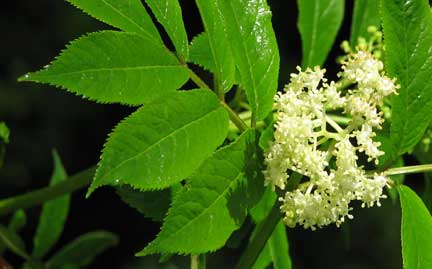 |
|
|
Trifolium repens
White clover, Dutch clover
Alaska to California, almost most of North America
Family Fabaceae
Non-native
White clover, native to Eurasia and North Africa but well naturalized to North America, is probably our most common clover. It is a perennial found in lawns, pastures, and along roadsides. It is purposely planted for cattle and sheep food, for honey production, and to improve soil for future crops by fixing nitrogen. Flower heads are white, sometimes with a pink tint, without an involucre, and having a long peduncle. Leaves are trifoliate, each leaflet ovate, finely toothed on its edges, and having a light-colored, U-shaped mark. It has creeping stems, and it roots at nodes.
|
|
|
|
 |
 |
|
Triglochin maritima
Seaside arrow-grass
All of Canada and the United States, except the Southern States
Family Juncaginaceae
Native
A member of the Arrow-Grass family, this unusual looking plant has flowers arranged in spikes or racemes up to two feet high. It grows sporadically in alkaline freshwater marches or salt marshes. It occurs in Netarts Bay in dense assemblages just above the Baltic Rush and the American Three-square. It forms tufts from a creeping rootstock and rhizomes. Leaves are fleshy, basal, rounded on one side, nearly flat on the other. In the photo of the cross section of the leaf, the light colored projections are four of the five vascular bundles that run the length of the leaf.
This plant is poisonous to cows, sheep, and other ruminants. It contains two cyanogenic glycosides, taxiphyllin and triglochinin, that release hydrogen cyanide during mastication. During drought, the level of toxicity can increase.
|
 |
 |
|
Trillium ovatum
Western trillium, trinity flower
British Columbia to California
Family Liliaceae
Native
The western trillium is one of the most emblematic and recognized flowers of the Pacific Northwest. It is our spring lily of the woods. This gorgeous three-petaled , usually white, flower grows locally along the wooded trails of Cape Lookout State Park and the Cape Meares Scenic Viewpoint where it is shaded by Douglas fir and Sitka spruce, western hemlock, red alder, sword ferns, and salal. You can not mistake the western trillium for any other flower. It has three broadly lance-shaped petals, which are usually white when young but can be pink or violet, six yellow stamens, three lanceolate sepals that lie between the petals, and three broadly ovate sessile leaves in a whorl atop a naked stem. Petals will also turn pink to purple with age. It is a perennial that grows from rhizomes. It likes wet winters but will tolerate dry summers.
|
 |
 |
|
Holodiscus discolor
Ocean spray, ironwood, creambush
British Columbia to California, other western states
Family Rosaceae
Native
Ocean Spray is a large perennial shrub or small tree that blooms in the early summer. Its cream-colored flowers are borne in pendent clusters that resemble the froth of an ocean breaker. Each fragrant flower is small, less than one eighth inch in diameter, with five petals and numerous stamens. Leaves are alternate. Each is has conspicuous veins, and toothed margins. It ranges in elevation from sea level to mountains. You can find it in our area along forest edges and open woods. The common name ironwood refers to its uncommonly hard wood, which can be made even harder by heating over a fire. It was used by western Native Americans for bows and arrows, digging sticks, and spear shafts.
|
 |
|
|
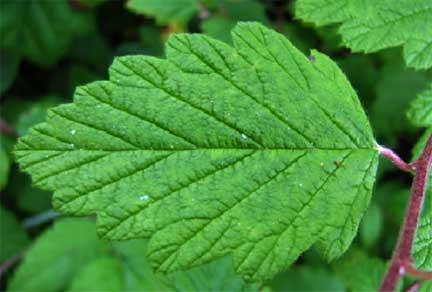 |
 |
 |
 |
|
Cerastium arvense
Field chickweed
Alaska to California, most of North America
Family Caryophyllaceae
Native
Chickweed is a common perennial in meadows, lawns, rocky outcrops, and coastal cliffs from low to sub-alpine elevations. I have found it in the Cape Lookout State Park campground. Flowers have five, deeply notched white petals that are two to three times as long as the sepals. Leaves are lanceolate, pointed at the tips, opposite, and covered with fine hairs. There may be group of secondary leaves in the leaf axils. It is rhizomatous, it grows close to the ground, and it flowers after its second year in the spring and summer.
|
|
|
|
Cerastium glomeratum
Sticky mouse-ear chickweed
Alaska to California, much of North America
Family Caryophyllaceae
Non-native
Imported from Eurasia, the sticky mouse-eared chickweed is common in fields, roadsides, open woods, and in our area on cliff faces. The one pictured here was on the cliff above Lost Boy Beach. It is a annual that is decumbent or somewhat erect with white flowers having five deeply notched petals that are equal in length to or shorter than the sepals. The inflorescence is arranged as a cyme. Leaves are sessile, opposite obovate and hairy, resembling mouse ears.
|
|
|
 |
 |
|
Clatonia exigua
Pale miner's lettuce, serpentine springbeauty
British Columbia to California
Family Portulacaceae
Native
Pale miner’s lettuce is an annual herb that grows close to the ground. It is glaucous and fleshy with a cluster of spatulate basal leaves and opposite stem leaves that are fused at their bases just beneath the inflorescence. Flowers are regular with five white petals that are about twice the length of the sepals. It likes our local sandy soils. I found this plant in the Cape Commity, growing along a trail to the beach.
|
 |
 |
|
 |
 |
 |
 |
 |
 |
 |
 |
 |
 |
 |
 |
 |
|
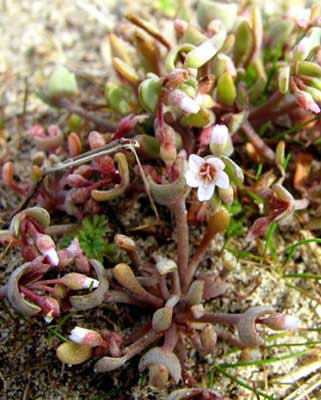 |
|
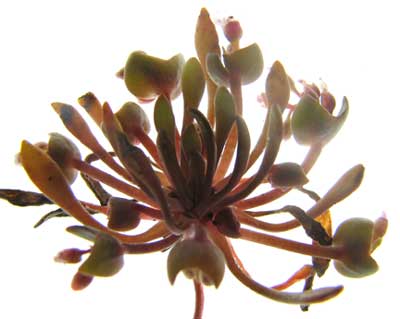 |
|
|
|
Conioselinum gmelinii
Pacific hemlock parsley
Alaska to California
Family Apiaceae
Native
Also known as C. pacificum and C. chinense, this is primarily a coastal plant that prefers damp soils. Local specimens were found at Cape Meares on the south pathway leading to the lighthouse. It is a perennial with a compound umbel inflorescence of small, white, five-petal flowers. Leaves are compound and pinnately divided with deeply lobed leaflets. The leaf petiole has a basal sheath that clasps the hairless stem. The fruit is ribbed with a short conical projection at the tip. The plant grows to about three feet high, and has an edible carrot-like taproot that was harvested by native peoples.
|
|
|
 |
|
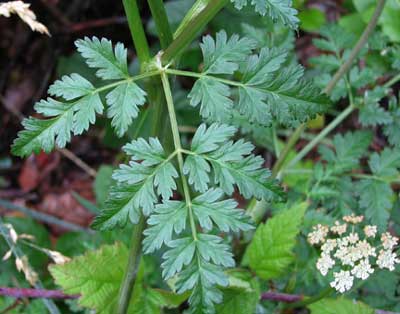 |
|
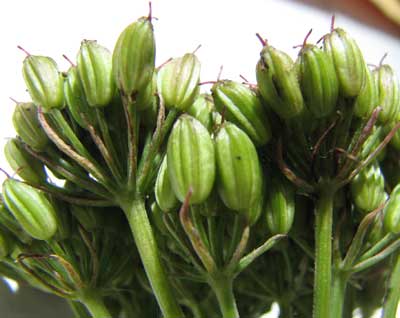 |
|
|
|
Hydrophyllum tenuipes
Slender stem waterleaf, Pacific waterleaf
Southern British Columbia to Northern Califorinia
Family Hydrophyllaceae
Native
Slender stem waterleaf occurs in shaded, moist forest, west of the Cascades. This specimen was found along the trail leading south from the Cape Lookout campground. It is a rhizomatous perennial. Greenish-white to lavender flowers are clustered at the end of a single erect stem. Each flower has five petals, five sepals that may be bristly on the margins, and five stamens which are twice as long as the petals and often have purple filaments. The pistil also protrudes from the center of the flower. Leaves are alternate, deeply lobed, and each lobe is toothed. Roots were eaten by Native Americans. Hydrophyllum is from Greek for “water-leaf” and tenuipes is derived from the Latin “tenuis” for slender.
|
|
|
|
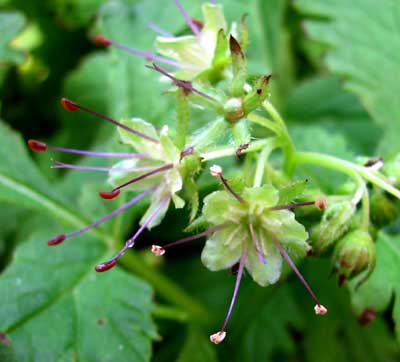 |
|
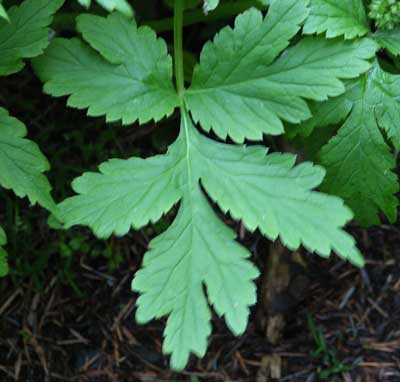 |
|
|
|
Click here to Return to Flowers - Page One
Click here for the Glossary
Click here for the References
Click here for the Introduction
Click here for Yellowish Flowers
Click here for Reddish Flowers
Click here for Bluish Flowers
Click here for Greenish Flowers
|
|
|
|
|

